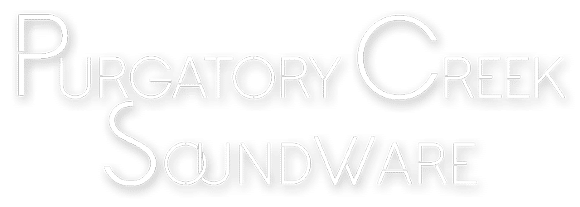EXs40 Mark I (1970)
The electro-mechanical piano, upon which this sample-set is based, was manufactured in the first week of 1970. It used tapered Raymac tines for sound generation. The Purgatory Creek Soundware Mark I was deeply sampled at 18 velocity levels recorded for the full duration, so you will hear neither loops nor artificial envelope decays.
The library takes up 928 MB of the SSD but only 34 MB of RAM thanks to disk streaming. Eleven programs are provided.
Updated for the Nautilus
EXs41 Mark V (1984)
Introduced in 1984, the Mark V piano was the last revision of the famous electric piano produced by the original Rhodes Company. It included many enhancements that resulted in a truly excellent instrument. The Purgatory Creek Soundware Mark V was sampled at 19 velocity levels for full duration, providing an accurate sound with no artificial decay envelopes or sample loops. It occupies 886 MB of disk but only requires 38 MB RAM.
Updated for the Nautilus
EXs140 Mark I (1975)
The electro-mechanical piano, upon which this sample-set is based, was manufactured in 1975, a year considered by some to be the golden era for this instrument. It featured the coveted Torrington tines. The Purgatory Creek Soundware Mark I (1975) was deeply sampled at 17 velocity levels recorded for the full duration, so you will hear neither loops nor artificial envelope decays. Nearly every note of the piano was sampled and eight velocity layers of note-off release samples are included.
The sample-set requires 1.8GB of RAM or 53MB using virtual memory. 25 programs are provided.
Updated for the Nautilus
EXs141 Mark II (1980)
The Mark II piano was noted for its modular action and Schaller tines, which give it a different sound than the earlier models. The Purgatory Creek Soundware Mark II (1980) was sampled at 13 velocity levels for full duration, providing an accurate sound with no artificial decay envelopes or sample loops. Nearly every note of the piano was sampled and eight velocity layers of note-off release samples are included.
The library requires 1.9GB of RAM or 48MB using virtual memory. 23 programs are included.
Updated for the Nautilus
EXs142 Mark II (1984)
Manufactured in 1984, this electro-mechanical tine-based piano was one of the last of the Mark II line. The Schaller tines give it a sound distinct from earlier pianos that used the Torrington or Raymac tines. The Purgatory Creek Soundware Mark II (1984) was deeply sampled at 18 velocity levels recorded for the full duration, so you will hear neither loops nor artificial envelope decays. Nearly every note of the piano was sampled and eight velocity layers of note-off release samples are included.
The library requires 1.7GB of RAM or 46MB using virtual memory. 21 programs are included.
Updated for the Nautilus
EXs154 Sparkletop
The electro-mechanical piano, upon which this sample-set is based, was manufactured in 1965. Unique to the Sparkletop series are traditional piano felt hammers (vs. neoprene tips on later models) and the Raymac tines. The Purgatory Creek Soundware Sparkletop was deeply sampled at 14 velocity levels recorded for the full duration, so you will hear neither loops nor artificial envelope decays. Nearly every note of the piano was sampled and seven velocity layers of note-off release samples are included.
The sample-set requires 1.9GB of RAM or 58MB using virtual memory.
Updated for the Nautilus
EXs156 DMP-EP "Dyno"
This electro-mechanical tine-based piano was manufactured in 1979 and modified by the San Francisco-based Dyno-My-Piano company. The modifications included an active EQ, voicing of the tine/pickups to create a bell or “dyno” sound as well as changes to the case to allow additional keyboards to be more easily stack on top of the piano. The Kronos contains a special emulation of the chorus (EP Chorus) which often associated with the “dyno” piano sound and it is included with most of the provided programs. The Purgatory Creek Soundware DMP-EP was deeply sampled at 18 velocity levels recorded for full duration, so you will hear neither loops nor artificial envelope decays. Nearly every note of the piano was sampled and eight velocity layers of note-off release samples are included.
The sample-set requires 1.8GB of RAM or 78MB using virtual memory. 20 programs are provided.
Updated for the Nautilus
-
Audio Demos

